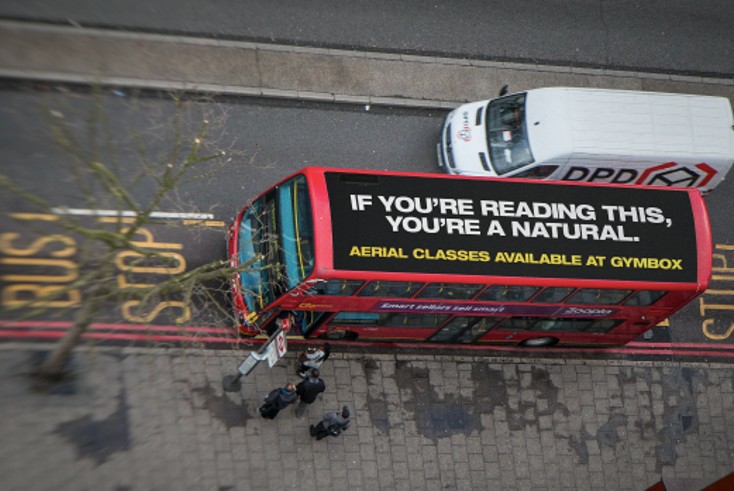Out-of-home media owners need to be “on their guard” in response to a rise of fake ads posing as billboards, one of the UK’s biggest outdoor media sellers has warned.
Clear Channel’s chief marketing officer for Europe told The Media Leader that brand reputations are at risk if the source of computer-generated outdoor ads created for social media fame are for fake campaigns.
It comes after London gym brand Gymbox launched a fake advertising campaign last week in which it pretended to have launched an advertising campaign that ran on the top of Transport for London buses. TfL confirmed that this type of ad, first used as a marketing stunt by The Economist newspaper in the 90s, could no longer be bought due to public transport regulations.
Gymbox did not respond to The Media Leader‘s request for comment over why it issued a press release last week claiming to have booked an ad campaign.
Martin Corke, UK chief marketing officer and Europe marketing lead for outdoor media owner Clear Channel, said: “Ads that masquerade as real cannot be a good thing, particularly if they mislead or even offend consumers. Brand reputations are potentially at risk of course if the source of the fake ad is scurrilously motivated.”
He added: “I suspect for some brands however it’s a bit of fun and faking an OOH ad creates a false sense of reality and stature. Overall however, I believe we need to be on our guard to both protect the unsuspecting public and hard fought brand reputations.”
A spokesperson for the Advertising Standards Authority (ASA) told The Media Leader if an ad did not run, which was the case with Gymbox’s fake bus top ad for aerial pilates and yoga classes, then “it would not be something that we could look into or be subject to our rules.”
Any public relations activity, including a press release, would not be classified advertising for the purposes of their Code, the spokesperson clarified. Similarly, user generated content (UGC) or “editorial” content only falls under the ASA’s remit when it has been adopted by or incorporated into a businesses’ marketing. For instance, if an advertiser takes the UGC and uses it or promotes it through their channels.
Recently there have been several examples using brands like Maybelline, Pandora and Apple. In a recent column, editor Omar Oakes said fake ads or branded ‘fan art’ “stand a much better chance of going viral when they marry bizarre activations with seemingly real world locations”.
Podcast: Why OOH audiences have not hit a ‘new normal’ yet – with Route’s Denise Turner
In a recent episode of The Media Leader Podcast, Denise Turner, Route Research CEO said: “This [Maybelline ad] has stunt written all over it but if it makes people think of out-of-home, I don’t think that’s a bad thing. But in the same way if you overuse something it stops having an impact so I think we need to be a bit careful about this.”
Tim Lumb, director of Outsmart, the trade body for the OOH industry echoed this as he acknowledged OOH is “fantastic for driving social engagement” so we should not be too surprised that fake OOH exists.
However, he told The Media Leader: “Fake OOH pilfers the real-world authenticity of OOH to make clickbait appear more genuine. I don’t know how anyone can reasonably stop people or organisations from making fake ads but if it continues beyond being a fad, then perhaps they could be reported/identified like other fake content is.
“Ultimately its diminishing returns because nobody likes being duped. The creative options in OOH are vast, so it’s better to be honest with audiences and just do it properly rather than trying to trick them,” he added.
Clear Channel has created an online mock-up maker to help clients visualise their prospective campaigns, which is particularly important for a brand that is new to OOH. These mock-ups are systematically watermarked unless customers register their contact details.
Phil Hall, Ocean Outdoor’s UK CEO, said it was great to see brands recognising the power that “well-executed OOH” can drive in the virtual and real world. OOH can optimise and power social conversations, which Ocean has established in research, which is something that “not all brands” are making use of at the moment.
However, Hall said that when brands share this content without appearing in the real world, aka a fake ad, “it becomes more complex.”
“Firstly, many established landlords have the IP rights on their properties and can act swiftly when brands misrepresent the relationship, “Hall said.
“However, there’s a more fundamental issue here. One of the core reasons to advertise is to gain the attention of a consumer and influence their behaviour. If a brand does this under false pretences, how does that affect their relationship with that consumer? I’d suggest at best these brands are taking a big risk. The best example of fake OOH I’ve seen are ones where the concept is obviously impossible — there’s no deceit there, just an imagination running wild and I believe consumers can tell the difference.”
Hall concluded: “My advice to brands is execute your idea in the real world and actively look to share the idea online. By doing this you retain your authenticity and if it’s done well you’ll get an army of people sharing your content with followers — completely free of charge. That’s what real success looks like.”
OOH look at me
Adwanted UK is the trusted delivery partner for three essential services which deliver accountability, standardisation, and audience data for the out-of-home industry.
Playout is Outsmart’s new system to centralise and standardise playout reporting data across all outdoor media owners in the UK.
SPACE is the industry’s comprehensive inventory database delivered through a collaboration between IPAO and Outsmart.
The RouteAPI is a SaaS solution which delivers the ooh industry’s audience data quickly and simply into clients’ systems.
Contact us for more information on SPACE, J-ET, Audiotrack or our data engines.





